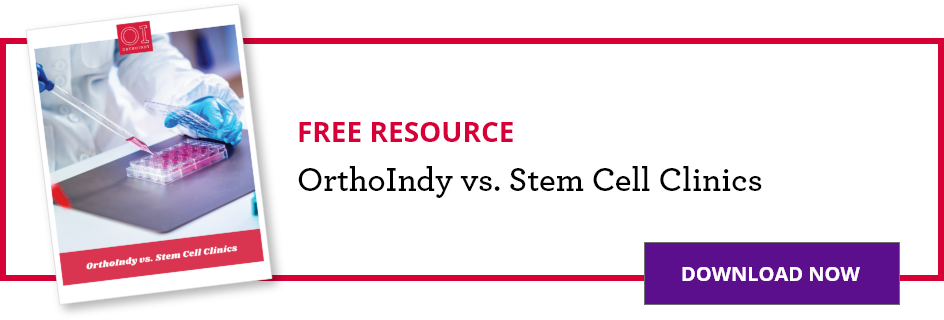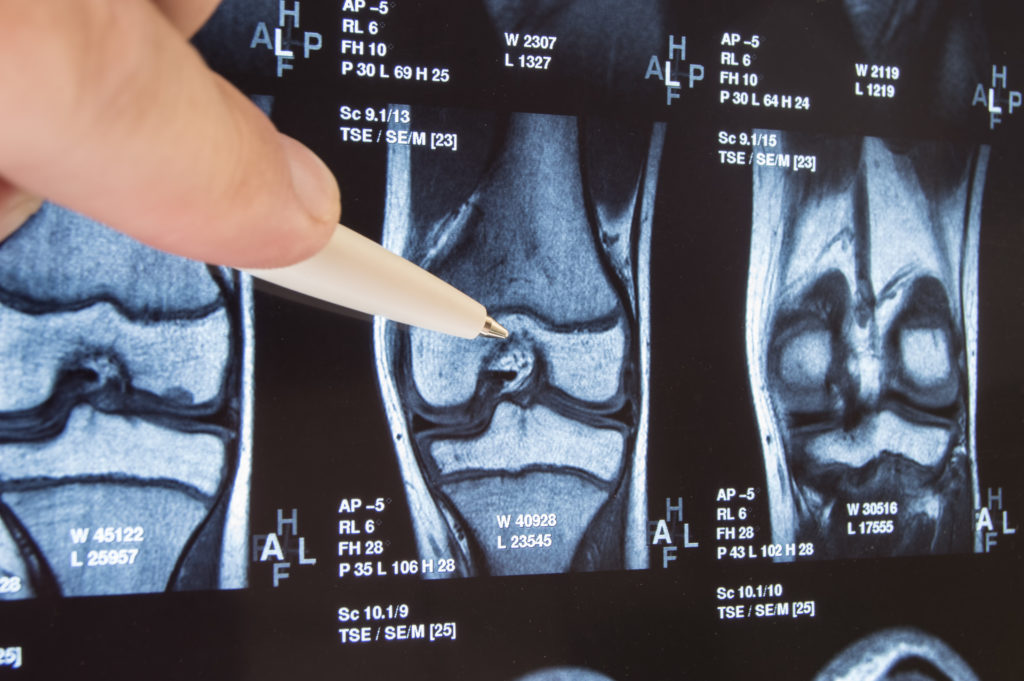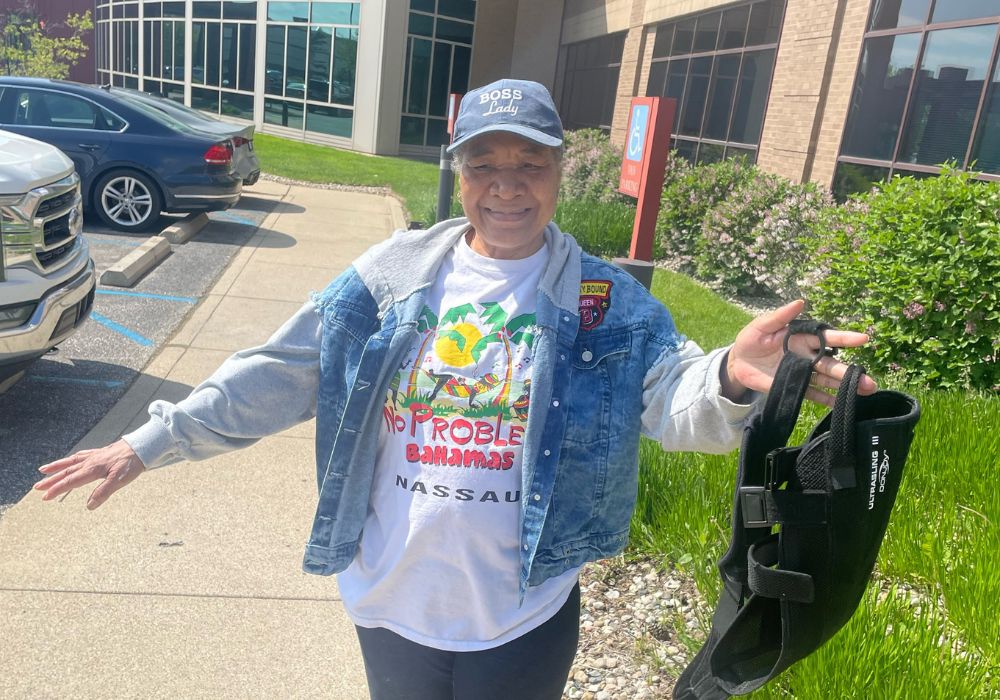THIS POST IS PART OF THE ULTIMATE GUIDE TO ORTHOBIOLOGICS
By: Jack Farr, MD
In the recent past, the popular press excitedly reported the promise of stem cells for all tissues of the body. Today, there remains a public perception that stem cells can “grow into anything” from a new pancreas to a new meniscus; however, in reality, stem cell research still has much to learn.
What are stem cells?
“Stem cell injections” are widely and improperly promoted. In the field of orthobiologics, the cells (previously termed mesenchymal stem cells), can be found in the bone marrow, muscle and adipose tissue (fat).
You may have heard or seen advertisements about “stem cell” treatments. The term “stem cells” is not approved by the Food and Drug Administration (FDA). And you should be leery of medical practices that claim they do “stem cell” injections. As a member of the Biologic Association, Dr. Jack Farr has led the way for the OrthoIndy OrthoBiologics program to adhere to the association’s ethical and scientific guidance.
The perception that “stem cells” can form any tissue is based on the fact, that indeed, they have the potential to form a variety of more specialized cells. The tissues that form joints (bone and cartilage) originate from mesenchymal signal cells most commonly isolated from the bone marrow. These rare cells can be used in a diluted state, concentrated or commonly multiplied through culturing. The uses for knee problems may be broadly categorized: injected or applied directly to a cartilage lesion.
Injected cells may be thought of either as small molecular factories, which influence the local environment of the knee (paracrine effect) or as directly influencing a “repair” (see Saw study below).
In a recently published study in the Journal of Bone and Joint, adult donor mesenchymal signal cells were injected into knee joints of patients who had undergoing partial excision of torn meniscal cartilage tissue in an effort to regrow the meniscus.
Dr. Farr participated in the multicenter study in which neither the physicians nor the patients knew if the patients received cells or not (Adult Human Mesenchymal Stem Cells Delivered via Intra-Articular Injection to the Knee Following Partial Medial Meniscectomy: A Randomized, Double-Blind, Controlled Study Thomas Vangsness, Jr., MD; Jack Farr II, MD; Joel Boyd, MD; David T. Dellaero, MD; C. Randal Mills, PhD; Michelle LeRoux-Williams, PhD JBJS Am, 2014 Jan 15;96(2); 90 90-98).
While definite meniscal regrowth was demonstrated statistically significant, the regrowth was not felt to probably be clinically significant. However, the patients who received the cells had diminishment of symptoms—with persistence over several months. (Also, see the blog on amniotic membrane and amniotic fluid cells injection study).

Comments about our Study
- http://www.sciencedaily.com/releases/2014/01/140116130957.htm?utm_source=feedburner&utm_medium=feed&utm_campaign=Feed%3A+sciencedaily+(ScienceDaily%3A+Latest+Science+News)
- http://www.news-medical.net/news/20140117/Single-stem-cell-injection-after-meniscus-knee-surgery-may-provide-pain-relief-aid-in-meniscus-regrowth.aspx
- http://www.technology.org/2014/01/18/stem-cell-therapy-following-meniscus-knee-surgery-may-reduce-pain-restore-meniscus/
- http://beyondthedish.wordpress.com/category/mesenchymal-stem-cells-2/
A second approach to injections was reported at a recent arthroscopy meeting (AANS, San Antonio 2013 by Dr. Adam Anz who presented Dr. Saw’s study) and published in Arthroscopy 2013 April. While the technique is not available in the US, Malaysian surgeons led by Dr. Saw reported improved patient outcomes comparing microfracture alone to patients who had cells serially injected in the knee after microfracture. Confirmatory, randomized controls will be important.
Alternatively, cells may be localized within a cartilage lesion either using an absorbable patch or fibrin glue. The bone marrow aspirate concentrate (BMAC) appears promising in the horse (Fortier et al JBJS 2010). Gobi reported similar positive results in the human (AJSM 2014) and confirmatory controlled studies in the human will be interesting to review.
Placing the cells directly into a cartilage defect with or without a patch after culturing has been expanded from the work by Wakatani and others in Japan published in 2010 (Wakitani et al Safety of autologous bone marrow-derived mesenchymal signal cell transplantation for cartilage repair in 41 patients with 45 joints followed for up to 11 years and 5 months. J TissueEng Regen Med 5(2):146–150). The case series outcomes appear promising and suggest the merit of a randomized comparative study. As in all areas of the knee, it is important to continue to apply the rigors of scientific investigation before adopting new technologies clinically.
To make an appointment with Dr. Farr please call 317.884.5163 or learn more about cartilage restoration.
Schedule an appointment
Your well-being is important to us. Click the button below or call us to schedule an appointment with one of our orthopedic specialists. If your injury or condition is recent, you can walk right into one of our OrthoIndy Urgent Care locations for immediate care. For rehabilitation and physical therapy, no referral is needed to see one of our physical therapists.





